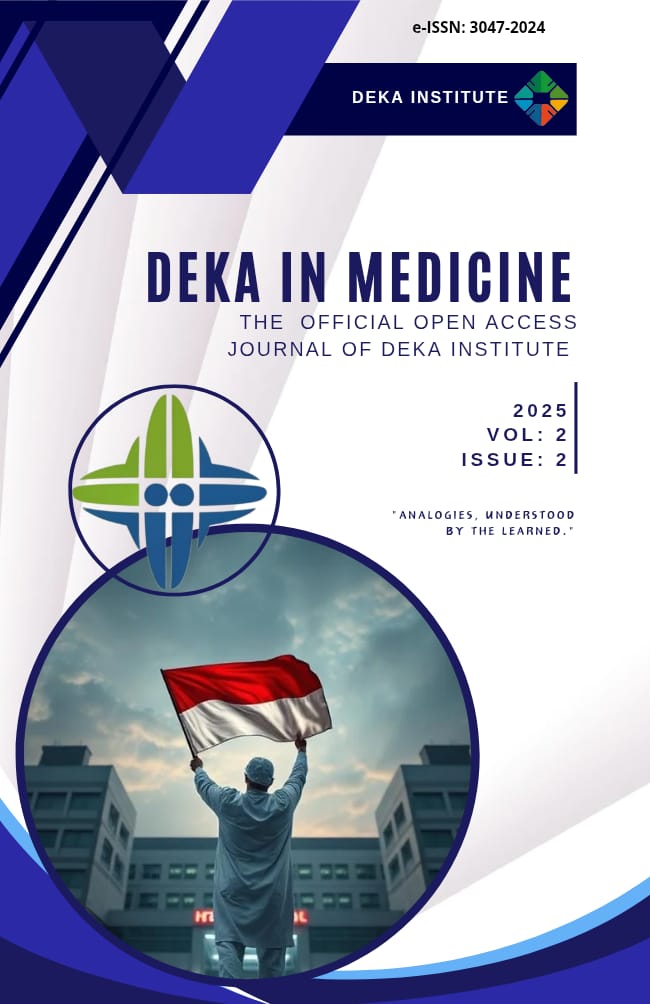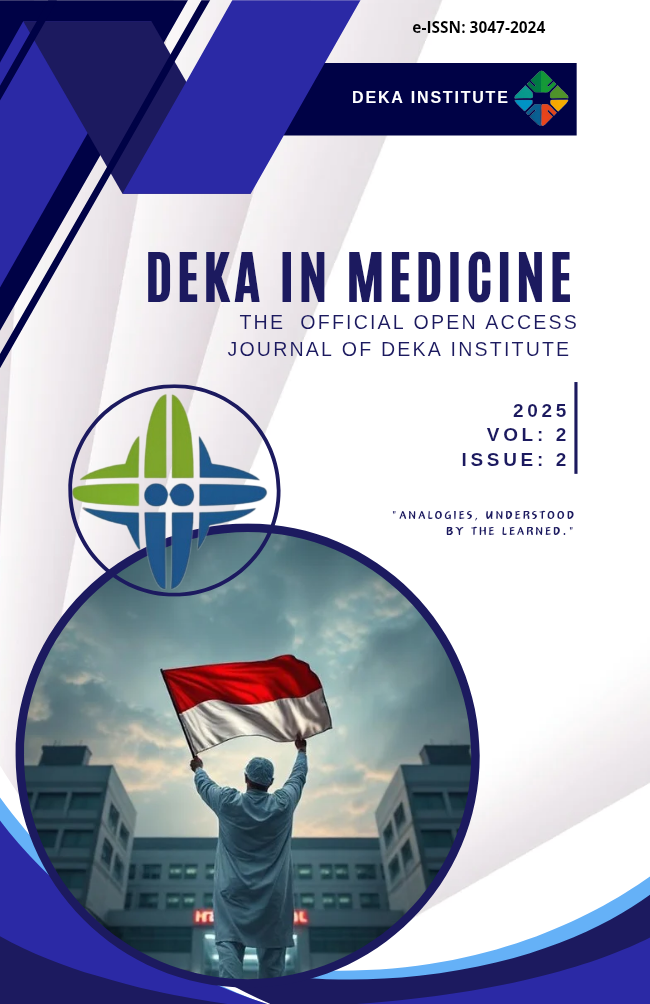Comparative study of SCFA and butyrate levels in chronic hepatitis versus cirrhosis patients
DOI:
https://doi.org/10.69863/dim.2025.e688Keywords:
Cirrhosis, chronic hepatitis, short-chain fatty acids, butyrate, gut microbiotaAbstract
BACKGROUND: Cirrhosis is a common complication of chronic liver disease and exerts a profound influence on gut microbiota and metabolic function. Short-chain fatty acids (SCFAs), particularly butyrate, are crucial to intestinal integrity and immunomodulation. The relationship between SCFA levels and the progression of liver disease is not well understood.
OBJECTIVES: The current study aimed to study the level of SCFAs and butyrate in fecal samples of patients with chronic hepatitis B, chronic hepatitis C, and compensated cirrhosis.
METHODS: The research was conducted at Dr. Saiful Anwar General Hospital, Malang, Indonesia, from January to June 2023. Fecal samples were collected and measured for SCFA and butyrate concentrations by gas chromatography. The comparison was made statistically by the Mann-Whitney U test between groups.
RESULTS: A total of 26 patients with chronic hepatitis B, chronic hepatitis C, or compensated cirrhosis were enrolled in the study. The overall mean SCFA level in the participants was 9.85 ± 4.78 mg/mL. The findings revealed no difference in the level of SCFA in chronic hepatitis patients and cirrhosis patients (p = 0.72). Likewise, there was no difference in butyrate levels between the two groups (p = 0.37).
CONCLUSION: During the present study, SCFA and butyrate levels were not significantly different in chronic hepatitis patients compared to cirrhosis patients. SCFA synthesis and use may be affected by various factors such as dietary patterns, microbiota diversity, and metabolic differences among individuals. Further studies with larger populations and dietary control are necessary to delineate the role of SCFAs in the pathogenesis of liver disease and therapeutic applications.
References
1. Fadlallah H, El Masri D, Bahmad HF, et al. Update on the complications and management of liver cirrhosis. Med Sci (Basel) 2025;13(1):13.doi: 10.3390/medsci13010013. PMID: 39982238
2. Gulcicegi DE, Goeser T, Kasper P. Prognostic assessment of liver cirrhosis and its complications: current concepts and future perspectives. Front Med (Lausanne) 2023;10(1):1268102.doi: 10.3389/fmed.2023.1268102. PMID: 37780566
3. Neag MA, Mitre AO, Catinean A, et al. Overview of the microbiota in the gut-liver axis in viral B and C hepatitis. World J Gastroenterol 2021;27(43):7446-7461.doi: 10.3748/wjg.v27.i43.7446. PMID: 34887642
4. Ramos Meyers G, Samouda H, Bohn T. Short chain fatty acid metabolism in relation to gut microbiota and genetic variability. Nutrients 2022;14(24):5361.doi: 10.3390/nu14245361. PMID: 36558520
5. Liu J, Yang D, Wang X, et al. Gut microbiota targeted approach in the management of chronic liver diseases. Front Cell Infect Microbiol 2022;12(1):774335.doi: 10.3389/fcimb.2022.774335. PMID: 35444959
6. Muljono DH. Epidemiology of Hepatitis B and C in Republic of Indonesia. Euroasian J Hepatogastroenterol 2017;7(1):55-59.doi: 10.5005/jp-journals-l0018-1212. PMID: 29201773
7. Nogal A, Valdes AM, Menni C. The role of short-chain fatty acids in the interplay between gut microbiota and diet in cardio-metabolic health. Gut Microbes 2021;13(1):1-24.doi: 10.1080/19490976.2021.1897212. PMID: 33764858
8. McBrearty N, Arzumanyan A, Bichenkov E, et al. Short chain fatty acids delay the development of hepatocellular carcinoma in HBx transgenic mice. Neoplasia 2021;23(5):529-538.doi: 10.1016/j.neo.2021.04.004. PMID: 33945993
9. von Elm E, Altman DG, Egger M, et al. Strengthening the Reporting of Observational Studies in Epidemiology (STROBE) statement: guidelines for reporting observational studies. BMJ 2007;335(7624):806-808.doi: 10.1136/bmj.39335.541782.AD. PMID: 17947786
10. Goodyear MD, Krleza-Jeric K, Lemmens T. The Declaration of Helsinki. BMJ 2007;335(7621):624-625.doi: 10.1136/bmj.39339.610000.BE. PMID: 17901471
11. Pohl K, Moodley P, Dhanda A. The effect of increasing intestinal short-chain fatty acid concentration on gut permeability and liver injury in the context of liver disease: A systematic review. J Gastroenterol Hepatol 2022;37(8):1498-1506.doi: 10.1111/jgh.15899. PMID: 35612373
12. Qin X, Chen M, He B, et al. Role of short-chain fatty acids in non-alcoholic fatty liver disease and potential therapeutic targets. Front Microbiol 2025;16(1):1539972.doi: 10.3389/fmicb.2025.1539972. PMID: 40248431
13. Philips CA, Augustine P. Gut barrier and microbiota in cirrhosis. J Clin Exp Hepatol 2022;12(2):625-638.doi: 10.1016/j.jceh.2021.08.027. PMID: 35535069
14. den Besten G, van Eunen K, Groen AK, et al. The role of short-chain fatty acids in the interplay between diet, gut microbiota, and host energy metabolism. J Lipid Res 2013;54(9):2325-2340.doi: 10.1194/jlr.R036012. PMID: 23821742
15. Xiong J, Chen X, Zhao Z, et al. A potential link between plasma short-chain fatty acids, TNF-alpha level and disease progression in non-alcoholic fatty liver disease: A retrospective study. Exp Ther Med 2022;24(3):598.doi: 10.3892/etm.2022.11536. PMID: 35949337
Downloads
Published
How to Cite
Issue
Section
License
Copyright (c) 1970 Syifa Mustika, Mochammad Fachrurrezza, Iraky Mardya Rakhmadhan, Adam Adam, Muhammad Reyhan

This work is licensed under a Creative Commons Attribution-ShareAlike 4.0 International License.

























